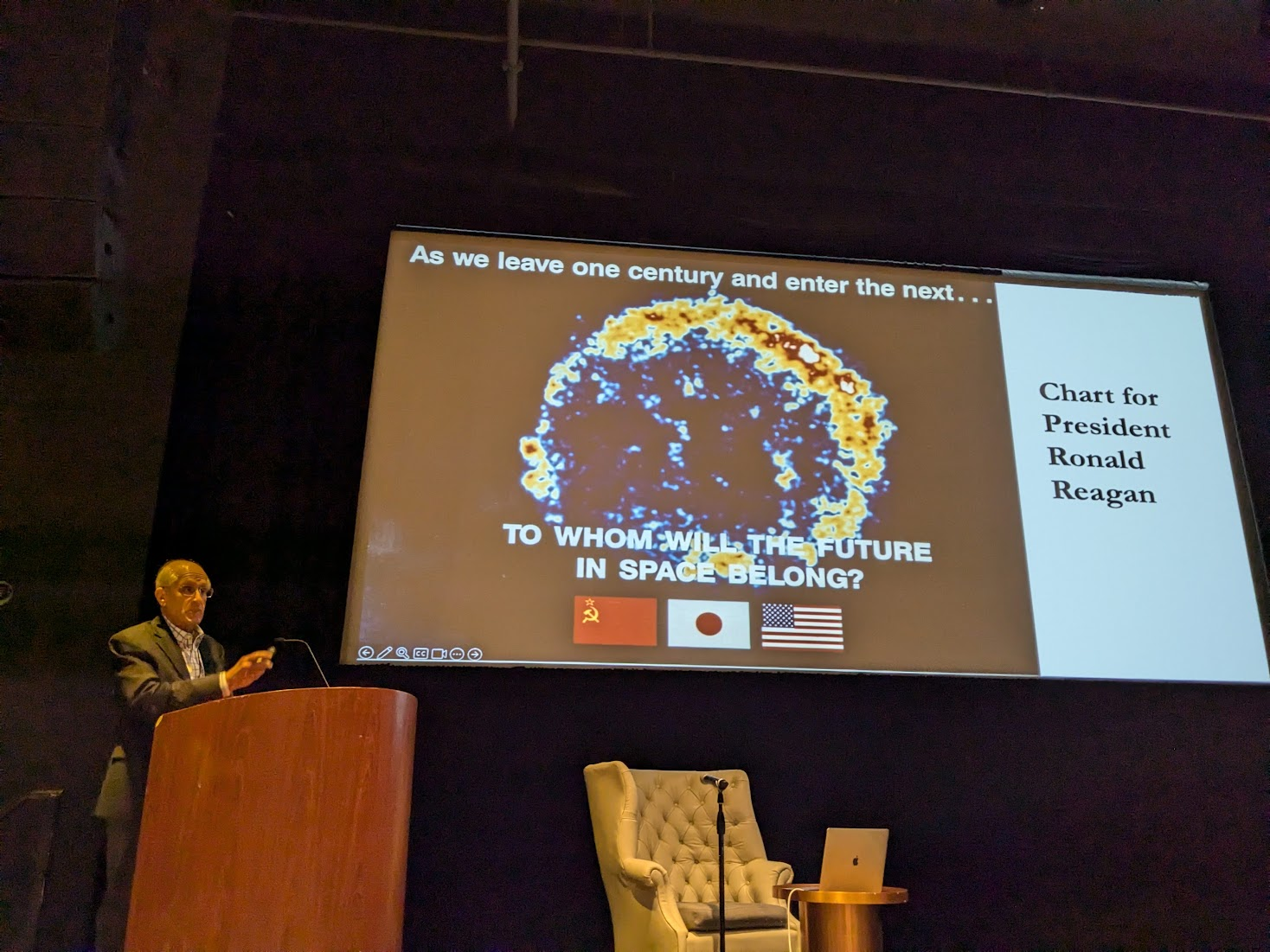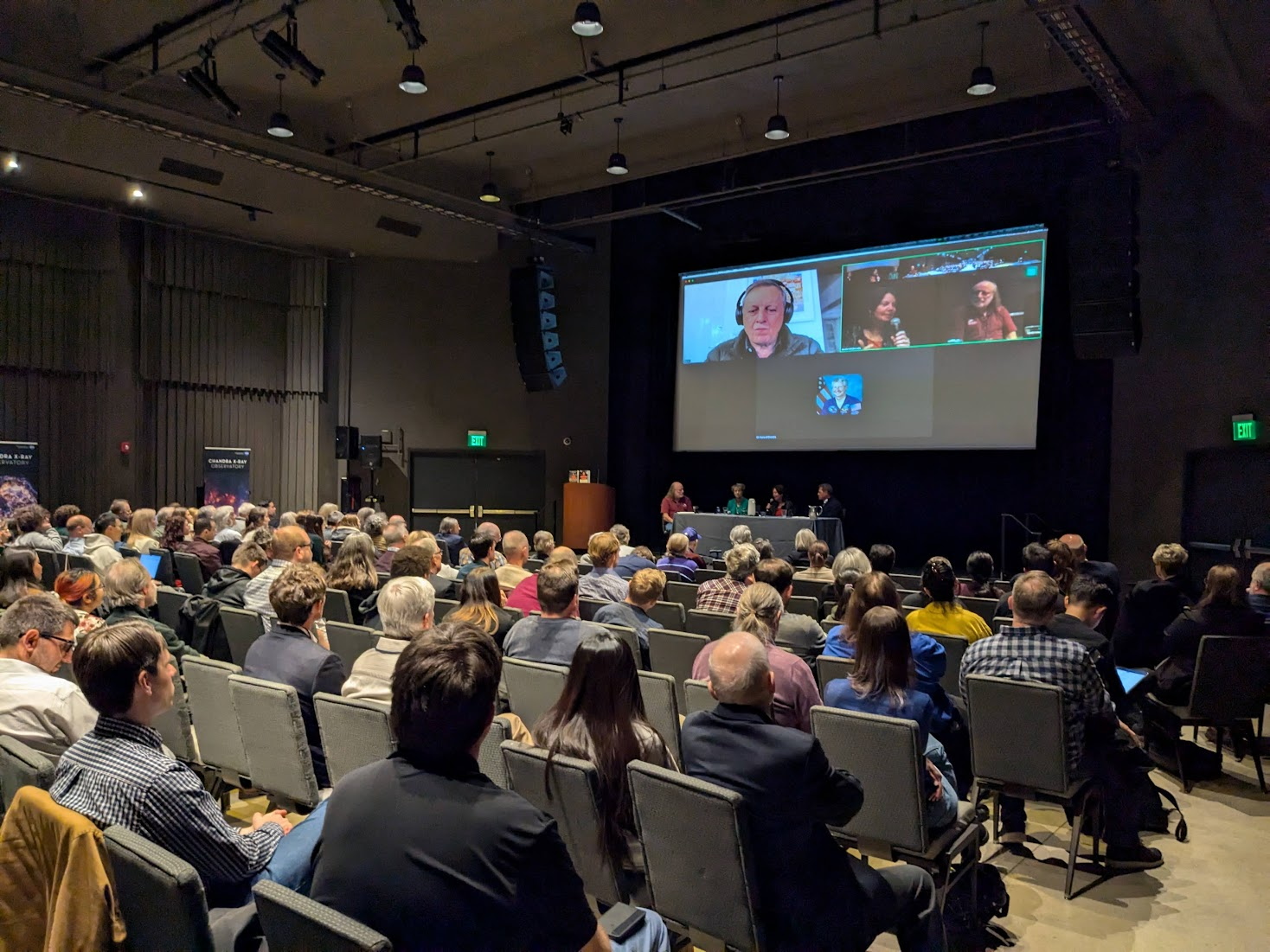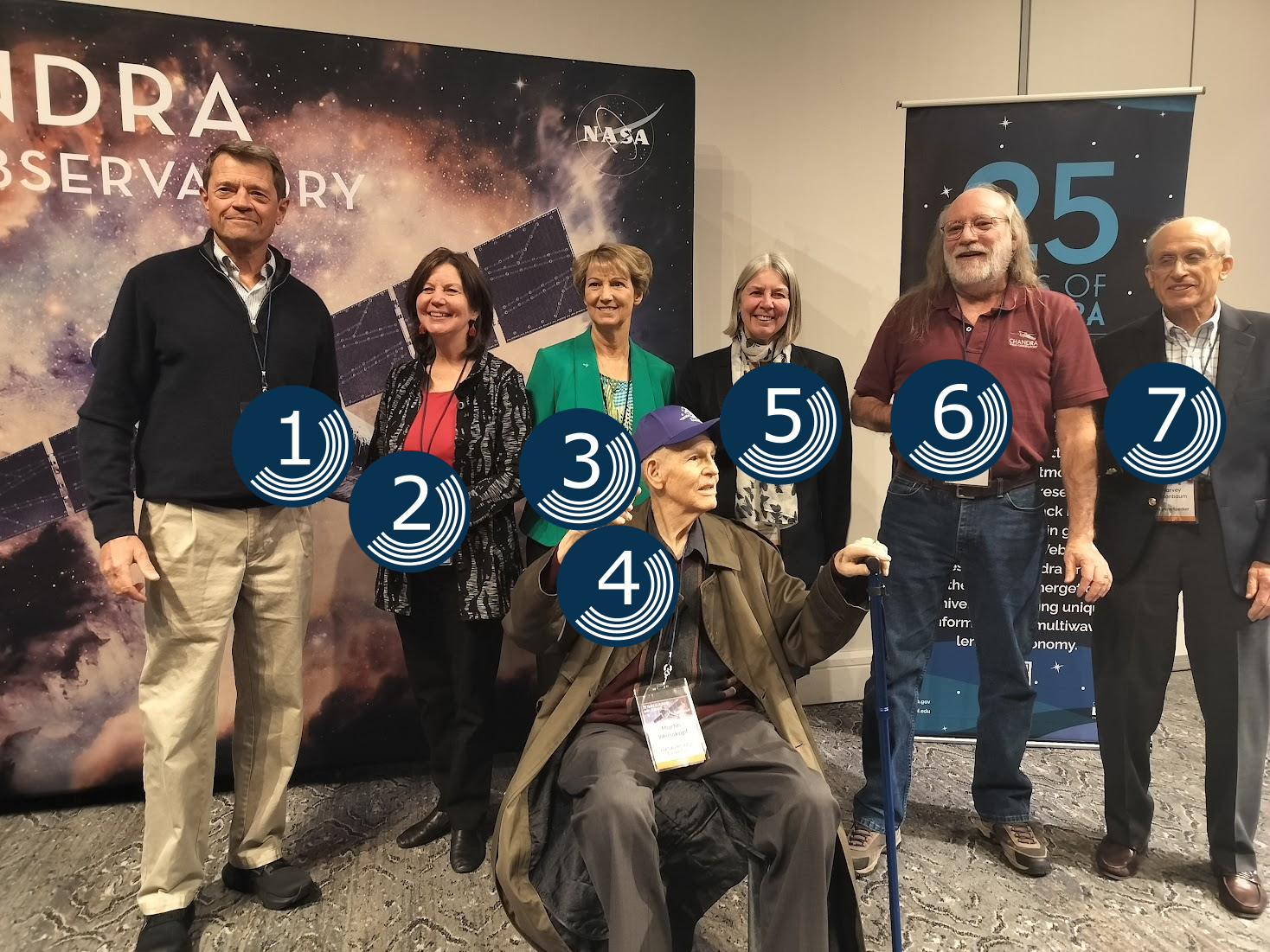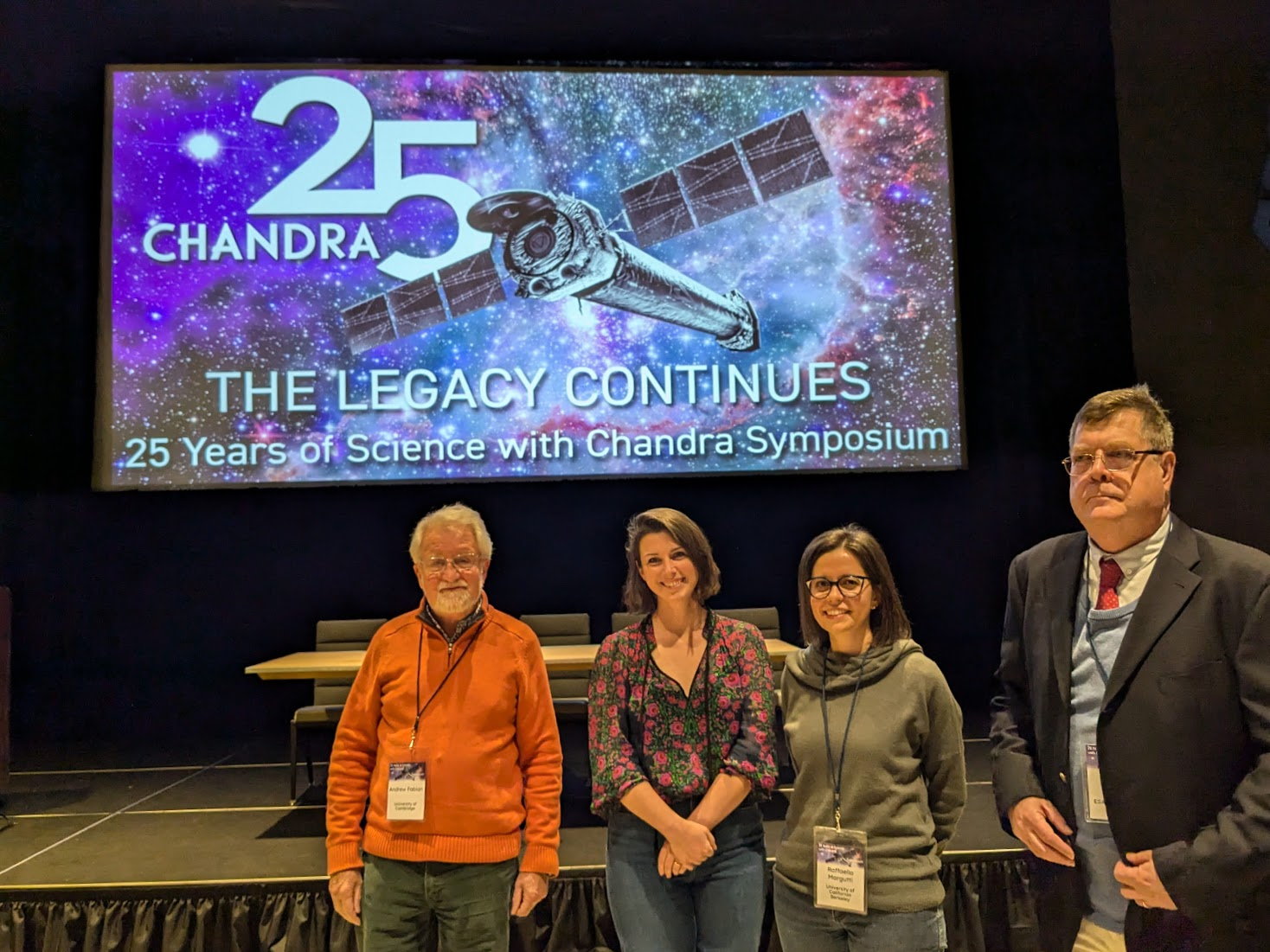The Legacy of 25 Years of Chandra
Amruta D. Jaodand & Dan Schwartz
The 25 Years of Science with Chandra Symposium was held from December 3 through December 6, 2024, in the historic Boston downtown at the Revere Hotel. The symposium celebrated the rich legacy of Chandra while highlighting the exciting discoveries to come, both enabled by the unique and unsurpassed capabilities of the Chandra mission.
It was a spectacularly successful symposium, with more than 275 astronomers in attendance (in person) from all over the world, signaling strong support and excitement for the mission in its 26th year of operation. The symposium was attended by leaders from the Smithsonian, the White House, NASA, the Marshall Space Flight Center, and by astronauts from the STS-93 mission, which launched Chandra in orbit.
A welcome note from Dan Schwartz and Amruta Jaodand, the chairs of the scientific organizing committee (SOC1), kick-started the symposium. The opening remarks were given by the current and former directors of the Chandra X-ray Center (CXC), Dr. Patrick Slane and Dr. Belinda Wilkes, respectively. This was followed by congratulatory remarks by Dr. Daniel Evans, the Director of Civil Space Policy, National Space Council of The White House. Dr. Evans presented congratulatory letters to the Chandra X-ray observatory (CXO) from the 46th President of the United States of America, Joe Biden, and the 49th Vice President of the United States of America, Kamala Harris. The letters recognized the pivotal role played by the CXO in pushing the frontiers of science over the twenty-five years of its operation.

Figure 1. The science program featured talks covering the entirety of Chandra's science, from the most distant black holes to exoplanets and the Solar System.
Dr. Evans's address was followed by the start of the science program for the symposium. The SOC worked tirelessly to design a captivating and diverse science program, carefully devising ten scientific sessions to highlight Chandra's broad impact. The themes were galaxies, clusters and cosmological parameters, stellar properties and environments, solar systems and exoplanets, compact objects, multi-wavelength synergies of Chandra, uniqueness of sub-arcsecond resolution in X-ray astronomy, sky surveys and catalogs, time domain and multi-messenger astrophysics, and AGN and feedback. Each session included an invited talk by a scientist with notable contributions in the given field, with invited speakers equally representing early, mid, and late career stages.
The invited speakers2 presented insightful talks on how Chandra had impacted their field in astronomy through a review of discoveries and outlined how the observatory will continue to contribute to the advancement of knowledge in the future. Each session was further enriched by contributed talks, with over 44 presented throughout the symposium. In addition, the symposium showcased nearly 80 science posters on exciting Chandra investigations and ongoing projects, plus 18 special posters from the CXC and instrument teams highlighting the ongoing developments and improvements made over the years. An archive of scientific talks presented at the 25 years of Science with Chandra symposium is available on the symposium webpage, and the archive of posters presented at the Symposium can be found at the symposium poster webpage.

Figure 2: Founding director of the Chandra X-ray Center, Harvey Tananbaum, presents slides during a retrospective discussion on the history of the mission. The slide shown here was critical in securing the needed funding for the mission.
Three special sessions were also held during the week. On the first afternoon, the founding Director of the CXC, Harvey Tananbaum, and the first NASA/MSFC Project Scientist, Martin Weisskopf, presented retrospective talks. They focused on the early years of Chandra from 1976 to 1999, and they both summarized the journey of taking Chandra from a vision to one of NASA's flagship Great Observatory missions. Their talks were filled with riveting stories about the challenges and how they overcame them. Particularly interesting was the story about how they managed to convince the government to continue funding the Chandra mission concept despite particularly strong headwinds in the late 1980's. Given the opportunity to present a single document to President Ronald Reagan, they created a strategic and high-impact chart with images of the Soviet, Japanese, and American flags, and one question—"As we leave one century and enter the next… to whom will the future in space belong?" The audience was immersed in this journey and enjoyed learning about the challenges faced in the first years.
In addition to celebrating the accomplishments of twenty-five years, there was an award ceremony recognizing the return to operation of the High Resolution Camera (HRC) following the retrospective session. The extended HRC team were presented with a plaque and certificates in recognition of their tremendous efforts to recover the HRC. The ceremony was led by Chandra's Project Manager Andrew Schnell from NASA/MSFC, who gave a short speech and presented the certificates to twenty awardees. More details on this award are available in the HRC article in this Issue.

Figure 3: Attendees listen attentively to Astronaut Catherine Coleman speaking during the first day's Astronaut session. On stage are also Eileen Collins and Jeffrey Ashby, along with panel moderator Pat Slane. Mission specialist Michel Tognini attended virtually.
The first day of the symposium concluded with a thrilling and informative presentation by the astronauts from STS-93, the Space Shuttle mission that deployed Chandra into orbit. Mission commander Eileen Collins, pilot Jeffrey Ashby, and mission specialists Catherine G. Coleman and Michel Tognini (virtually) were in attendance for the session. They recounted the launch of the spacecraft, how a communications issue led to loss of the forward link to Columbia, and the tense moments before getting Chandra in orbit due to an earlier-than-anticipated main engine cutoff. They also answered several audience questions about being an astronaut and how they prepared for the mission in an era of highly manual missions. The session was followed by an evening reception and a toast to the Chandra mission presented by CXO director Patrick Slane.

Figure 4: Some of the special speakers who presented on the first day. As numbered on the photo, they are 1: Jeffrey Ashby, STS-93 Pilot; 2: Catherine Coleman, STS-93 Mission Specialist; 3: Eileen Collins, STS-93 Commander; 4: Martin Weisskopf, original NASA/MSFC Project Scientist; 5: Belinda Wilkes, CXC Director emerita; 6: Pat Slane, CXC Director; 7: Harvey Tananbaum, CXC Director emeritus.
The second day of the symposium opened with brief remarks by the director of the Center for Astrophysics | Harvard & Smithsonian, Dr. Lisa Kewley. Dr. Kewley also introduced the under secretary for science and research at the Smithsonian Institution, Dr. Ellen Stofan, who congratulated the Chandra team in her remarks.

Figure 5: Panelists (from left to right) Andrew Fabian, Erin Kara, Raffaella Margutti, and Norbert Schartel before their panel discussion on Thursday.
A third special session on Thursday saw a panel discussion at the symposium on "the future of X-ray astronomy," which was followed by audience-wide questions. Led by moderator Grant Tremblay, the panelists Erin Kara, Andy Fabian, Raffaella Margutti, and Norbert Schartel did a wonderful job of addressing the questions such as "what are the important new observations that only Chandra can do?" and "what future Chandra Legacy programs can have a major impact on the decadal science questions?" Each panelist gave short, five-minute talks and answered questions from the audience.
Lastly, this article would be incomplete without our gratitude to the phenomenal local organizing committee3, which worked hard for more than a year to ensure a smooth execution of the symposium.
1. The scientific organizing committee members were Mojegan Azadi, McKinley Brumback, Jeremy Drake, Hannah Penn Earnshaw, Steven Ehlert, Pepi Fabbiano, Victoria Grinberg, Julie Hlavacek-Larrondo, Amruta Jaodand, Elisabeta Lusso, Herman Marshall, Priya Natarajan, Michela Negro, Jack Steiner, Daniel Schwartz, and Tea Temin
2. The Chandra X-ray Center is grateful to invited speakers: Professor Lia Corrales from the University of Michigan; Professor Daryl Haggard from McGill University; Professor Bret Lehmer from the University of Arkansas; Professor Laura Lopez from Ohio State University; Professor Tom Maccarone from Texas Tech University; Professor Eileen Meyer from the University of Maryland, Baltimore County; Dr. Rafael Martínez Galarza from the Center for Astrophysics | Harvard & Smithsonian; Professor Joseph Neilsen from Villanova University; Professor David Pooley from Trinity University; and Professor Katja Poppenhager from the University of Potsdam.
3. The local organizing committee consisted of the following CXC members: co-chairs Thomas Connor and Amruta Jaodand, as well as Jason Conry, Katie Cranmer, Tara Gokas, Padmanabhan Ramadurai, Aldo Solares, Evan Tingle, Antonella Fruscione, and Rodolfo Montez Jr.